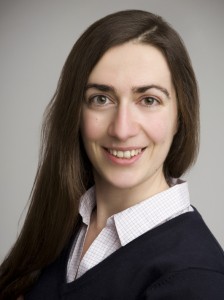During the DGK meeting in Stuttgart 2016, Julia Dshemuchadse, one of the founding members of the Young Crystallographers, stepped down from her function as co-chair of the Young Crystallographers to make way for the next generation. I took me a while to get hold of her (oh those busy post-docs…) for a little chat and to take a closer look at Julia and her past work within the community.
Julia started out at Technische Universität Dresden in 2002 and finished her studies in Nanostructural Physics by the end of 2008. During her studies, she also worked as a research assistant. In the beginning of 2009, she started her PhD thesis at the Laboratory of Crystallography at ETH Zurich. Julia finished her thesis on intermetallic compounds in 2013 and stayed at ETH Zurich until the beginning of 2015 as a post-doc. She was awarded with the Max-von-Laue Prize of the German Crystallographic Society in 2015 for her outstanding work during her time at ETH Zurich. Currently, she is commonly seen at the University of Michigan at the Department of Chemical Engineering in the Biointerfaces Institute doing some Monte Carlo and Molecular Dynamics simulations as part of her Early-Post-Doc-Mobility grant from the SNSF.
Why have you started building up the „Arbeitskreis“ Young Crystallographers?
The Young Crystallographers were founded at the annual DGK meeting in 2013, which was hosted by Prof. Dirk Meyer in Freiberg. Together with Prof. Sibylle Gemming (Dresden and Chemnitz) he had scheduled a kick-off meeting for this group. When I saw its announcement I was immediately interested.
Prof. Meyer had been my advisor during my time as a diploma student in Dresden and he approached me and asked me whether I would volunteer to be the first chairperson of the Young Crystallographers. At first, I was a little worried that I did not have the necessary experience, but it was important to me that this group would be established and I was willing to invest some time into starting it. I had also just defended my PhD thesis, so maybe I felt like I needed a new challenge ;).
I was glad that Oliver Pecher volunteered to join me as a co-chair during the kick-off meeting and after the DGK member assembly officially approved of the Young Crystallographers, we immediately started to set up the website and to start to build a network of and for upcoming crystallographers.
In your opinion, what was your biggest success within the Young Crystallographers?
I think, Oliver and I are very proud of how the 1st Meeting of the Young Crystallographers in Bremen in 2014 turned out. Prof. Thorsten Gesing had offered to host our group’s first meeting and Hanna Lührs, then working in Prof. Reinhard X. Fischer’s group, was instrumental as the local organizer.
The concept of the meeting, the use of 5-minute lightning talks and extensive poster sessions, as well as the insider talks from industry crystallographers were nothing that we had experienced ourselves and we were very glad when we realized how well-received the meeting was.
Motivated by this success, we introduced the Lightning Talks as standalone microsymposia to the annual DGK meetings, which in my opinion is an exciting new way of having younger scientists present their projects and, in turn, getting an overview of the rich research landscape committed to crystallography in Germany and beyond.
What was the most interesting/exciting part of being co-chair?
Almost everything was exciting at first, as I never chaired a group like this before and had not done scientific service work to this extent at that point. The work with the Young Crystallographers team was very rewarding and I am grateful to have gained insights into the workings of organizing scientific events and other aspects that are relevant to life in academia. In retrospect, it is great to know that the Young Crystallographers will keep offering a platform to students, PhD students, and postdocs in this scientific community.
What are you going to do now?
I am currently a postdoc at the University of Michigan – being this far away was one of the reasons why I was convinced that someone closer to Germany would be more able to support the Young Crystallographers in every aspect. I will continue my research here for another one or two years and I will continue to assist the current chairs in an administrative role.
Do you have any final words to the community?
Please keep supporting the chairs and their team with your feedback, ideas, input, insights, and suggestions! Crystallography is a very diverse field and academia is a diverse workplace; we all can only build on our own set of experiences and the more people from different backgrounds contribute to shaping the Young Crystallographers and therewith the future of the DGK, the better.
